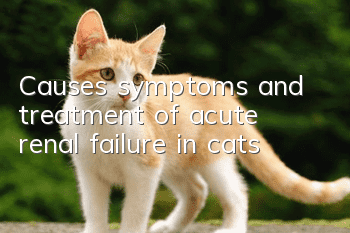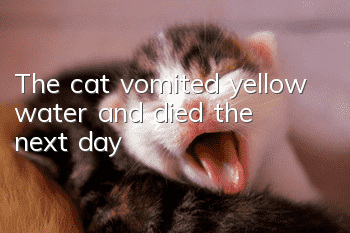Causes, symptoms and treatment of acute renal failure in cats

Acute renal failure in cats is a very common disease, and often due to emergency onset, the prognosis is often poor and the mortality rate is still very high
Today let’s talk about the causes, symptoms, diagnosis and treatment of acute renal failure in cats
Causes of acute renal failure
Why do cats suffer from acute renal failure?
In terms of pathogenesis, acute renal failure is caused by a sudden decrease in glomerular filtration rate
Under normal circumstances, the permeability of the glomerular filtration membrane is relatively constant.
However, in some cases, the glomerular filtration rate can temporarily change
For example, during intense exercise, elevated body temperature, severe hypoxia, increased carbon dioxide, or increased sympathetic nervous tension, the animal body redistributes blood through its own regulation, thereby greatly reducing the blood flow through the kidneys.
When there is severe hypoxia, increased carbon dioxide, or increased sympathetic nervous tension, in order to ensure sufficient blood flow to the brain and heart, the animal body also significantly reduces renal blood flow through self-regulation. As renal blood flow decreases, filtration pressure decreases and filtrate decreases.
Acute renal failure can be classified into two categories according to its pathogenesis:
First, acute renal hypoperfusion (i.e. ischemia)
The second is caused by renal poisoning
Acute renal failure can be divided into three categories: prerenal, renal and postrenal based on the location of the disease.
1. Prerenal failure is basically acute renal failure caused by simple insufficient renal perfusion.
The causes of prerenal failure are:
① Heavy bleeding
② Severe diarrhea and vomiting
③Burn
④ Water accumulation in body cavity
⑤Shock
⑥Heart failure
⑦ Impairment of blood vessels in the kidney itself, etc.
For example, a cat may suffer from acute renal failure due to severe bleeding due to injury.
2. Renal failure Renal and post-renal renal failure are caused by acute renal failure caused by the dual effects of ischemia and poisoning.
① Renal failure mainly includes various infectious diseases, poisoning and other factors. It can be understood that the first site of disease is the kidneys.
The acute kidney disease directly caused by these pathogenic factors causes local acute ischemia, renal tubular basement membrane disease, renal blood vessel obstruction, etc., thus leading to the occurrence of acute renal failure.
For example, kidney failure caused by lily poisoning in cats is renal failure.
② Post-renal renal failure usually refers to obstruction of glomerular filtration caused by urinary tract obstruction, stones, etc., or damage or tumors, and at the same time causes lesions and necrosis of the basement membrane of the renal tubules, leading to acute renal failure.
For example, acute renal failure caused by anuria in cats is postrenal renal failure.
Symptoms of acute renal failure
Although acute renal failure is sudden, it does not mean that there are no clinical symptoms
Typical symptoms of cats suffering from acute renal failure are as follows:
① Sudden depression and lethargy
②Anorexia
③ Vomiting and diarrhea
④ Oliguria or polyuria
⑤ Even tremors and coma.
In the early stages of renal failure, cats have significantly reduced urination or even no urine based on the primary disease (such as hemolysis, burns, blood loss, shock, etc.).
Metabolites of water, salt, and ammonia cannot be excreted in the body, leading to a series of metabolic disorder symptoms, such as edema, hyperkalemia, hyponatremia, acidosis, uremia, and even clinical symptoms such as heart failure. symptom.
At this time, secondary infection and other complications are very likely to occur.
Among them, the anuria period varies in length, ranging from about 1 week to 2 to 3 weeks. Even long-term anuria
After a cat passes through the oliguric period, due to the animal's body's own regulation, the compensatory reabsorption function of the renal tubules is enhanced and the urine output increases. This period is often called the polyuric period
During the polyuria stage, edema begins to subside and blood pressure gradually decreases, but usually biochemical examinations can find that blood nitrogen rises in the early stages of this period.
At the same time, due to the loss of water, potassium, and sodium, the clinical manifestations are weakness of the limbs and even lying on the ground, irregular heartbeat, and even shock. In severe cases, sudden death may occur due to tremors.
Generally it lasts for 1 to 2 weeks. If you can endure it, you can enter the recovery period.
During the recovery period, the urine output gradually recovers and a series of clinical symptoms gradually disappear.
However, because the cat consumes a large amount of protein in the first two periods and consumes a lot of physical energy, it still shows weakness in its limbs, muscle atrophy, and physical weakness during the recovery period.
PS: If glomerular function cannot be restored for a long time, it may turn into chronic renal failure.
Judgment of acute renal failure
So, how to diagnose acute renal failure in cats?
In fact, a preliminary diagnosis can be made based on medical history and clinical symptoms. Of course, clinical X-ray examination, B-ultrasound examination and multiple laboratory tests can further confirm the diagnosis.
① X-ray examination and B-ultrasound examination can roughly determine the size of the kidneys. If the renal abnormalities are more obvious, X-ray films can be usedMake a judgment
② In addition, urine density is often used clinically as a standard to judge kidney function. The density of normal cat urine is 1.015 to 1.060. Small urine output and low density are typical features. The urine sodium concentration is high. Red blood cells, white blood cells, and various casts and proteins can be seen in the urine.
In the polyuria stage, the urine output is large but the urine density is still low, and white blood cells can be seen in the urine.
③ Blood tests mainly look at blood images and serum biochemical indicators. Usually the total number of white blood cells and the proportion of neutrophils are increased, and creatinine, urea ammonia, phosphate, and potassium levels are increased.
④ Animals in the oliguric stage can also be diagnosed by a fluid rehydration test. After rehydrating the animals in the oliguric stage (250~500mL), diuretic drugs (diurea or furosemide 5~10mg) are injected intravenously. If there is still no urine or oliguria, those with low density can be diagnosed as acute renal failure.
Treatment of acute renal failure
The treatment principles of renal failure are based on actively treating the primary disease, preventing dehydration and shock, correcting hyperkalemia and acidosis, and alleviating azotemia.
For example, when a cat suffers from kidney failure due to trauma, burns or severe infection, the primary disease should be actively treated first, but antibiotics with less toxicity to the kidneys should be used during the treatment
If acute renal failure is caused by poisoning, the source of the poison should be cut off, fluids should be replenished appropriately, and appropriate antidote should be selected as soon as possible.
If the kidney failure is caused by urinary tract obstruction, you should urinate as soon as possible. In special cases, surgical methods can be used to eliminate retained urine before replenishing fluids appropriately.
If dehydration or hemorrhagic shock occurs, fluids should be rehydrated in time, and dexamethasone should be injected intramuscularly or subcutaneously.
Diuretics should be used as soon as possible during the oliguric stage of renal failure in cats. If acidosis occurs at this time, intravenous injection of 5% sodium bicarbonate in glucose saline is required. If it is accompanied by heart failure and hyperkalemia, If necessary, use lactated Ringer's solution instead;
If hyperzotemia occurs, 25% to 50% glucose solution can be injected intravenously after dehydration is corrected. At the same time, protein intake must be limited, and high-energy and vitamin foods must be supplemented.
In the polyuria stage of renal failure in cats, the above treatment methods can be adopted in the early stage. However, as the amount of urine increases, it is easy to cause electrolyte imbalance. Pay attention to replenishing electrolytes and replenishing potassium in time to avoid the occurrence of hypokalemia. .
During the recovery period, cats need to supplement nutrition and provide high-protein, carbohydrate and vitamin-rich food.
Although acute renal failure is acute and harmful, sick cats will have obvious clinical symptoms. As long as we discover it in time and take timely treatment measures, the chances of the cat being rescued will be greatly improved!
- How to train a Persian cat to use cat litter
- What is the average lifespan of a Bombay cat?
- What does it mean when a cat meows repeatedly?
- Can cats eat hairy clams?
- Can cats eat salty fish?
- Do cats need rabies vaccinations?
- How to train a Siamese cat? Teach you how to train a Siamese cat!
- Several things to note after cats are vaccinated
- Tips on feeding pet cats, a must-read for cat lovers!
- Why does a cat vomit? Why cats vomit!



